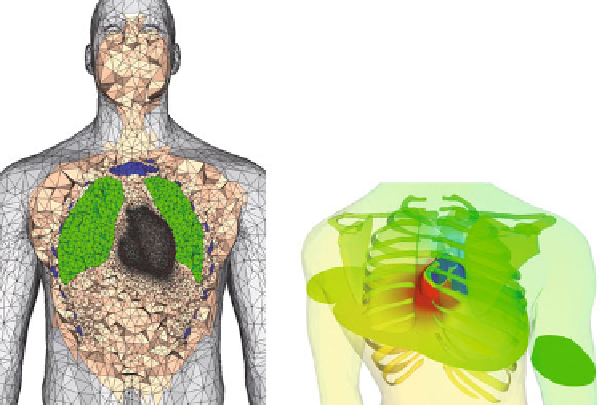Biomedical Engineering Reference
In-Depth Information
Fig. 4.3.
Left
: cut view of the heart-torso computational mesh. Heart (red), lungs (green), bone
(blue) and remaining tissue (apricot).
Right
: posterior view and cut plane of the torso and heart
potentials at time
t
=
10 ms
∈
N
∗
Let
N
be
a
given
integer
and
consider
a
uniform
partition
def
=
{
[
t
n
,
t
n
+
1
]
}
0
≤
n
≤
N
−
1
, with
t
n
n
τ
, of the time interval of interest
(
0
,
T
)
, with
def
=
∂
τ
x
n
+
1
time-step size
τ
T
/
N
. The notation
represents a (first or second order)
x
n
+
1
backward difference formula,
the corresponding explicit extrapolation (i.e.,
def
=
x
n
or 2
x
n
x
n
−
1
)and
I
app
−
I
app
(
·,
t
n
)
. The space
X
H
,
h
(resp.
X
T
,
h
) is the internal
approximation of
H
1
(resp.
H
1
) made of continuous piecewise-affine
functions. Moreover, we assume that the restrictions of
X
H
,
h
and
X
T
,
h
match at the
interface
(
Ω
H
)
(
Ω
T
)
Σ
. The resulting fully discrete time advancing procedure reads as follows:
for 0
≤
n
≤
N
−
1,
1. Ionic state: find
w
n
+
1
∈
X
H
,
h
such that
∂
τ
w
n
+
1
)
ξ
=
(
V
n
+
1
m
w
n
+
1
+
g
,
0
(4.15)
Ω
H
X
H
,
h
.
2. Heart and torso potentials: find
V
n
+
1
m
for all
ξ
∈
X
H
,
h
,
u
n
+
1
and
u
n
+
1
T
L
0
(
Ω
H
)
∈
∈
X
H
,
h
∩
∈
e
X
T
,
h
with
u
n
+
1
u
n
+
1
e
=
on
Σ
, such that
T
χ
m
Ω
H
∂
τ
V
n
+
1
V
n
+
1
m
u
n
+
1
e
φ
+
Ω
H
σ
i
∇
(
+
)
·
∇φ
m
I
n
+
1
app
)
φ
,
I
ion
(
V
n
+
1
w
n
+
1
=
−
,
m
Ω
H

